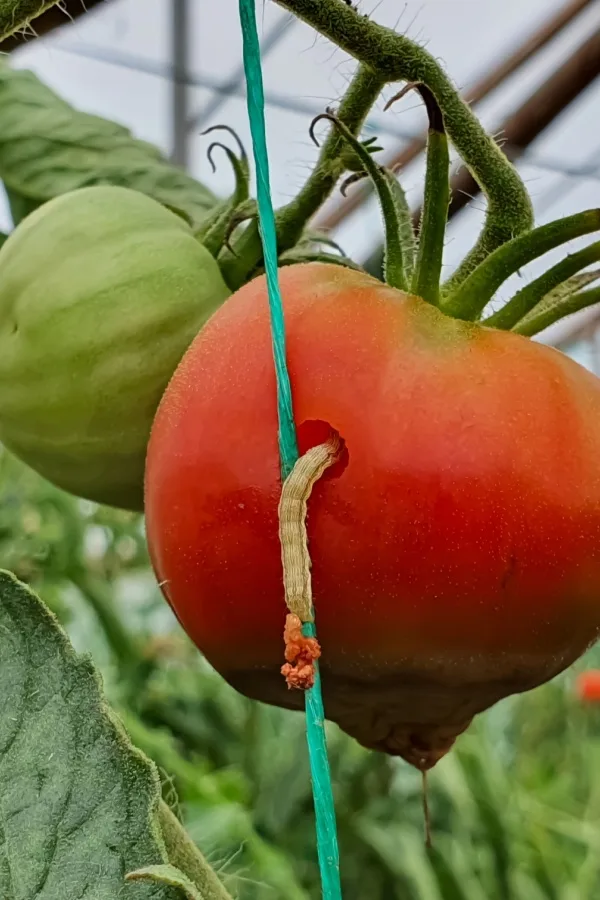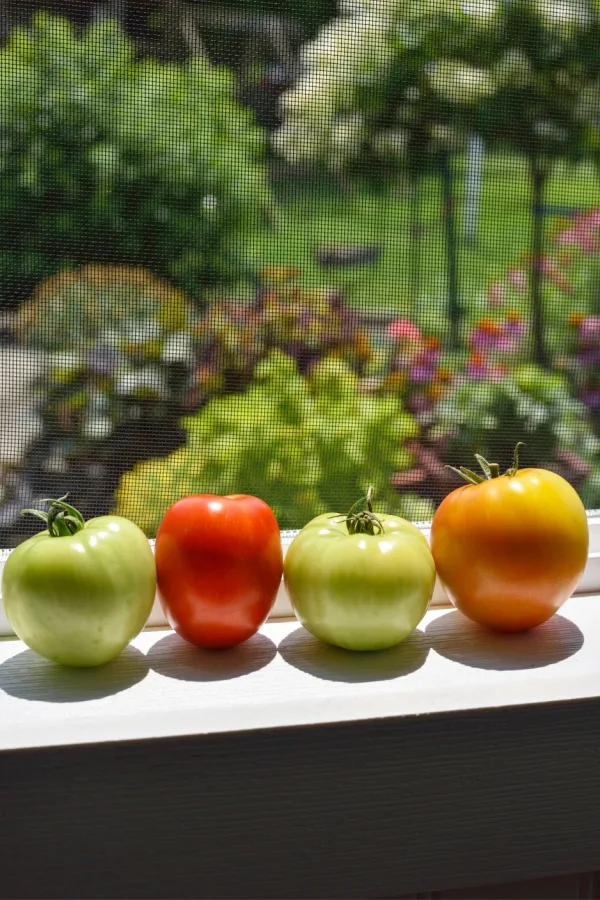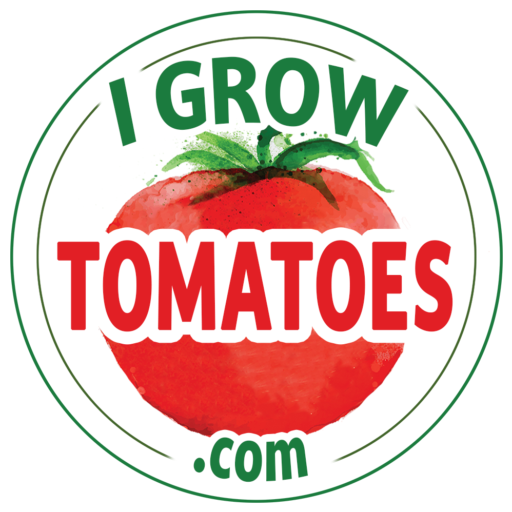Did you know that the best way to ripen tomatoes is actually off the vine – and not by leaving it on the plant? Especially late in the season, when all kinds of pests and other issues can affect them when they stay on the plant!
It’s true! Although those bright red, juicy tomatoes look beautiful growing on your tomato plants, as it turns out, leaving tomatoes on your plants to fully ripen can cause all kinds of issues – both for your tomato plants – and the tomatoes growing on them.
Unfortunately, gardeners aren’t the only ones who find juicy, red-ripe tomatoes on a plant appealing! Many garden pests like insects and birds, are also attracted to the fully ripe fruit. And the longer those tomatoes sit on the vine, the higher the chances are that the tomatoes will get snacked on by those pests.

Not only that, but having an overload of ripening tomatoes on your plants starts to get extremely heavy, especially for slicing varieties. Often, all of that weight ends up causing stems and branches to bend and break, damaging the plant and tomatoes in the process.
Perhaps most important of all, leaving too many tomatoes on the vine can also slow the production of your tomatoes. But how do you know when the right time is to pick your tomatoes and what do you do with them after they are harvested? Well, that’s what today’s article is all about!
How To Ripen Tomatoes Off The Vine
A Few Facts About Ripening Tomatoes
As soon as a tomato starts to turn from green to a hint of its mature ripe color, the fruit has started its ripening process. This is what is known as the breaking stage.
It’s at this point that even though there might be very little color showing, a fruit can continue to ripen off the vine. It no longer absorbs any nutrients from the plant so it can be harvested and left to ripen elsewhere.
That’s not to say that the plant doesn’t try to continue sending its energy and resources. However, the fruit can no longer absorb that energy or take in the nutrients provided. It all ends up going to waste instead of being spent on setting new blooms and growing fruit.

Benefits Of Ripening Off The Vine
As mentioned, allowing tomatoes to fully ripen off the vine helps save the plant’s vital nutrients and energy. But there are several other different reasons why you should consider ripening tomatoes off the vine as opposed to on the vine.
First, there is an increase in damage to the plant itself. Even tiny cherry tomatoes can greatly weigh down branches and stems. If those growing fruit are all allowed to stay on the stems while they ripen, the chances increase that the weight can bend or break the stems during times of heavy rains or high winds.
There’s also the risk of fruit overload with indeterminate tomatoes. This occurs when there are too many ripening fruits on the plant at one time. When this happens, the plant actually slows down the production of new blooms and fruit. So the earlier you pick, the more blooms the plant can produce.
Damage To The Fruit
Next, there’s the issue of pests. The longer tomatoes stay on the vine, the more likely it is that some pest will get to them first. And it’s not just the crawling pests like slugs or tomato hornworms you have to worry about either. Raccoons, deer, and groundhogs all enjoy feasting on ripe tomatoes. See, “How To Keep Tomato Hornworms Off Your Tomato Plants!”
Another issue that can happen is cracking and splitting skins. Fluctuations with rain or watering can cause the fruit to grow faster than their skins, causing the skins to split. These cracks are an open invitation for diseases and pests to make their way in.
The sunlight, high temperatures, and even humidity can also cause issues with tomatoes splitting and softening. This leaves the harvested fruit mushy and otherwise unappealing.

Now that you know why it’s better to ripen tomatoes off the vine, let’s take a look at just how to accomplish the task so you end up with the best tasting, blemish-free tomatoes around!
When To Pick Tomatoes & Where To Store Them
While you can pick tomatoes as soon as they start to turn their mature color, it’s best to wait until 1/4 of the fruit has changed color. At this stage, the fruit is still firm and likely free of blemishes or damage. In addition, once you harvest fruit at this stage, it ripens quickly and evenly.
As opposed to what you’ve likely read about or seen online, the best place to put the ripening fruit is not on a sunny windowsill. Direct sunlight can cause the fruit to ripen unevenly and too quickly. In addition, the heat from the sunlight can end up slipping or blistering the skin of the tomato just like it would if it were still on the plant.
Instead, keep your tomatoes in a shaded location that is out of direct sunlight. A location that stays consistently around 60 to 70º Fahrenheit is ideal.
Avoid Flat Surfaces
In addition, the tomatoes need plenty of natural airflow. Placing them on a wire drying rack, metal welded patio tables, or even a shelf made from mesh welded wire works best. This allows the air to get to all surfaces of the fruit and results in even ripening.

Don’t place the tomatoes on your countertop, on a baking sheet, or on other flat surfaces. The flat surfaces result in soft spots on the fruit. If you have no choice but to use a flat surface, store fruit upside down. This way the tomato shoulders take the brunt of the weight instead of the weaker bottom.
Avoid The Refrigerator – Ripen Tomatoes Off The Vine
Another common misconception is storing tomatoes in a refrigerator. However, placing the fruit in a cold location will actually stop the ripening process altogether. In addition, the tomatoes will start to lose their intense flavor and their texture will change if stored in a refrigerator.
If you prefer to enjoy cold tomatoes on your BLT sandwich, however, you can definitely place one in the fridge a few hours before consuming it. Just avoid keeping one for more than a couple of days in the chilly space.
Here’s to enjoying juicy, blemish-free tomatoes all summer long by ripening them off the vine as opposed to on the vine!
I Grow Tomatoes
Follow Our Facebook Page For Even More Great Tomato Growing Tips! I Grow Tomatoes Facebook Page
I Grow Tomatoes is a website created for those who love all things about tomatoes – from planting and growing – to cooking and canning! We publish two articles every week, 52 weeks a year. Sign up today to follow via email! This article may contain affiliate links.
